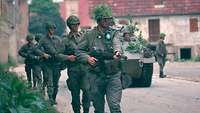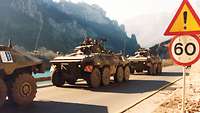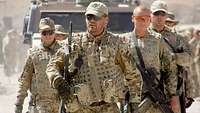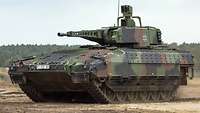The History of the German Army
The history of the German Army is a key element of the Bundeswehr’s history. Since 1950, when the “Blank Office” was founded, the German Army as the largest armed service has undergone many reforms as a result of changes in foreign and security policy. From the beginning, the German Army was incorporated into the NATONorth Atlantic Treaty Organization structures.
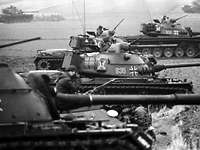
The “Blank Office”
On 26 October 1950, Theodor Blank was appointed “Chancellor’s Commissioner for Questions with Regard to the Strengthening of Allied Troops”, and what was known as the “Blank Office” was founded. Almost five years later, on 7 June 1955, it was converted to the Federal Ministry of Defence, and Theodor Blank was sworn in as the first Federal Minister of Defence of the Federal Republic of Germany. Directorate-General V: Army was established in the Federal Ministry of Defence. It comprised three divisions for the functional areas: leadership and training, organisation, and logistics.
Not long after, on 12 November 1955, Theodor Blank was finally able to place the first 101 volunteers in the service of the Bundeswehr in an impromptu ceremony held in the former Ermekeil Barracks in Bonn. Since then, this has been considered the date of the Bundeswehr’s establishment. In early 1956, seven training companies were formed in Andernach for the Army. They were the Bundeswehr’s first units. Initially, 12 Army service schools were established starting on 1 July 1956. Throughout its history, the Army took on several different structures in order to adapt to the continually changing political parameters.
The Federal Ministry of Defence’s Directorate-General V: Army developed a whole new army structure. The initial plans for this Army Structure 1 were by and large very freehanded. The NATONorth Atlantic Treaty Organization earmarked forces from the Army alone were to comprise 320,000 military personnel. The plans also called for a Troop Office, Army schools and fixed depot facilities.
Army Structure 1 (1956 to 1958)
In Army Structure 1, the organisational structure of the Army was partly based on the USUnited States model. Each of the three national corps was to lead four divisions. The plans specified six armoured divisions and six infantry divisions.
Later that year, on 5 October 1956, the law stipulating 12 months of military service was passed, so the first 10,000 conscripts entered the barracks on 1 April 1957. However, under the new Federal Minister of Defence Franz Josef Strauss, the peacetime strength of the Army in the field was initially reduced to 195,000 military personnel at the end of 1956.
In 1958, shortly after the buildup of the Army began, its structure had to be reconsidered owing to new security parameters. The introduction of tactical nuclear theatre weapons by the Soviet armed forces required the Bundeswehr to adapt to the new nature of threats.
Army Structure 2
Army Structure 1’s very large divisions with up to 28,000 troops seemed too unwieldy for employment under nuclear conditions. The potential effects of adversary nuclear weapons had to be minimised. For that reason, the focus of these considerations shifted to the idea of mobile defence with the capability for rapid-reaction counterattacks. Accordingly, smaller, more mobile units had to be formed.
Army Structure 2’s new concepts therefore primarily addressed the structure of the divisions. The brigade was introduced as a smaller basic element within the division. Unlike the battle groups, the brigade had organic formations and units even in peacetime. For one thing, this simplified interaction in combined arms combat. For another, it reduced the time and effort required to achieve operational and defence readiness.
At the end of 1959, eleven divisions with a total of 27 brigades had been set up. The personnel strength of the Army was about 148,000. The infantry divisions were now known as armoured infantry divisions.
Factors such as the heightened threat situation after the Berlin Wall was built on 13 August 1961 caused basic military service to be extended to 18 months as of 1 April 1962.
In 1969, the Army Staff was reorganised once again. As the Army was increasingly being equipped with helicopters, a separate section for airmobility tasks was created.
The 1970s
In the mid-1970s, the threat situation changed. While the USUnited States and the USSR had the same levels of strategic nuclear weapons, the Soviet Union managed to advance its dominant position in the medium and intermediate range.
On 12 December 1979, NATONorth Atlantic Treaty Organization responded to this development with the Double-Track Decision, which called for modernisation of the medium-range and intermediate-range nuclear ballistic missiles starting in 1983 while at the same time inviting the Soviet Union to negotiate mutual limitation of medium-range and intermediate-range systems.
The Army Staff responded to this development in two ways. New materiel, such as the HOT and MILAN anti-tank guided missiles and the Gepard self-propelled armoured air defence gun system, was introduced, and new weapon systems – in particular, the Leopard 2 main battle tank, the Roland self-propelled antiaircraft gun and the antitank helicopter – were developed.
Since the mid-1960s, the Army Staff had been considering how the Army’s existing structure could be adapted to the conditions of NATONorth Atlantic Treaty Organization’s new “flexible response” strategy.
Army Structure 3
The ratio of combat units to combat support units was to be improved. Since the Army had not been equipped with battlefield nuclear weapons, conventional area fire weapons were needed in their place. Against the backdrop of increasing operational costs and limited budget funds, the motto for Army Structure 3 was “specialisation with graduated operational readiness”. The concept of light infantry was developed to adapt each of the major units to the specific terrain of their employment areas.
Two armoured infantry divisions were to convert their brigades into light infantry brigades, becoming light infantry divisions. This reduced the amount of armoured and armoured infantry units, which in turn reduced the operational costs. The concept of “graduated operational readiness” was intended to further reduce costs. While the brigades were to remain fully manned and equipped, the corps and division troops were to be organised as reserves.
At the end of 1971, the Army in the field was divided into four armoured divisions, four armoured infantry divisions, two light infantry divisions, one mountain division and one airborne division.
The concept of the following structure was designed for greater mobility during initial deployments and was intended to allow to faster formation and shifting of points of main effort in combat.
Army Structure 4
The most dramatic changes in Army Structure 4 were at the brigade and battalion levels. At these levels, a larger number of smaller combat elements and units were to form, resulting in a larger number of commanders, while maintaining the high level of operational readiness. The number of combat battalions in the brigades increased from three to four, and mixed armoured and armoured infantry battalions were established.
With Army Structure 4, the Army in the field comprised three corps with twelve divisions. The former 2 and 4 Light Infantry Divisions were converted to armoured infantry divisions, and 1 and 7 Armoured Infantry Divisions were converted to armoured divisions. The total of 38 active brigades were divided into 17 armoured, 15 armoured infantry, three airborne and one mountain infantry brigade, as well as the active units 51 Home Defence Brigade in Eutin and 56 Home Defence Brigade in Neuburg an der Donau, which were assigned to NATONorth Atlantic Treaty Organization as of 1982.
The changing Soviet politics under President Mikhail Gorbachev fundamentally eased the tensions in the East-West conflict.
Army Structure 5 and German reunification
In the second half of the 1980s, extensive changes were made to the Bundeswehr’s structure and size. Due to the low birth rates in those years, it would have been impossible to maintain what was then a force strength of 495,000 without extending basic military service. Accordingly, the German Bundestag had already decided in April 1986 to extend military service from 15 to 18 months as of 1 June 1989.
At the same time, a far more fundamental change was underway. Federal Chancellor Helmut Kohl’s successful meeting with President Gorbachev in the Caucasus in July 1990 defined the terms of German reunification. Nevertheless, the peacetime strength of what was now the reunified German Bundeswehr was to be a maximum of 370,000 military personnel. The required reduction had to be made by the end of 1994, when the Soviet armed forces were supposed to have completely withdrawn from Germany. After years of building up the armed forces with only brief periods of consolidation, the Bundeswehr and therefore also the Army now faced their first period of downsizing while also restructuring the armed forces.
Shorter military service
Against the backdrop of German reunification and the new personnel strength specified for the Bundeswehr, the personnel levels planned for Army Structure 5 up to that point no longer applied. The peacetime strength of the reunified German Army was to be reduced to around 255,000 military personnel by the end of 1994. The plans were based on a strength of around 40,000 military personnel as an appropriate portion of the Army in the territory of the former East Germany. Two other factors were to be taken into account in the plans: Firstly, the duration of military service was shortened from 15 to 12 months as of 1990. Secondly, it was important to ensure that the Army had national command and control capability.
Binational formations
The number of brigades was to be reduced from 48 to 26 manoeuvre brigades with varying levels of operational readiness. The military subregion commands were to be disbanded, while the number of military region commands was to be increased from 29 to 46.
The expansion of the Bundeswehr’s task spectrum, the intended multinationality of the corps staffs and funding cuts led to an adjustment of Army Structure 5 at the end of 1992.
Army Structure 5 (N) involved dissolution of the territorial commands and therefore abandoning the idea of their amalgamation with corps headquarters in peacetime. At the same time, the corps became a key factor in the German Army’s multinationality. In April 1993, II Corps became II German-American Corps. I Corps was disbanded in August 1995, and I German-Netherlands Corps was formed in its place. One of the two tactical/operational division staffs was removed from the plans, and the remaining one was converted to the Airmobile Forces Command and charged with administrative control of the three airborne brigades.
The Army of the future (2000/2003 to 2006)
The “fundamental renewal of the Bundeswehr” and the “Army of the future” continued the gradual developments that had taken place in the years before – from a Bundeswehr intended to be able to engage in defence against a mechanised adversary at the national borders within 48 hours, to one on operations worldwide within the framework of international conflict management. The transition to an “army on operations” needed to be reflected in the structure of the armed forces. The reform of the Army officially started on 21 July 2000 when the “directive on detailed planning of the armed forces of the future” was issued.
The Federal Minister of Defence’s political guidelines required that the Army be able to perform the following spectrum of tasks:
National and collective defence
Crisis and conflict management
Special operations
Disaster relief and assistance operations
Orienting the Army’s structure towards the most likely operations was at the heart of this reform. In order to support allies outside of Germany, the Army had to be prepared to contribute forces on the scale of a reinforced mechanised division (major operation). As an alternative to this major operation, the Army was to be able to provide a force level of up to 10,000 military personnel on two simultaneous operations (medium-sized operation) for a long period of time within the framework of conflict prevention and crisis management.
In addition, a force level of around 1,000 military personnel was to be earmarked (small operation) for national preparedness for operations to rescue and evacuate German citizens, for protection of Germany’s own forces against terrorist threats, and for operations for the purposes of humanitarian aid and disaster relief.
The Army loses 40 percent of its personnel
The “fundamental reorientation of the Bundeswehr” meant that the Army was to focus on its core tasks. Support tasks were transferred to the new major organisational elements: the Joint Support and Enabling Service (JSES) and the Bundeswehr Joint Medical Service. The JSES and the Bundeswehr Joint Medical Service relieve the armed services of all non-mission-oriented tasks in both routine duty and national territorial tasks. In addition to their individual operational missions, they act as service units.
The new division of tasks had a direct effect on the personnel staffing levels. While there had still been some 225,000 military personnel serving in the “New Army for New Tasks”, the strength of the “Army of the future” was only 134,000. The Army lost 40 percent of its personnel, but had to increase its readily available operational forces at the same time.
However, more than 50,000 Army military personnel were also transferred to the Joint Support and Enabling Service and the Medical Service along with the tasks these elements took on. In the “armed forces of the future”, 190,000 military personnel – and therefore also the majority of the military personnel in the JSES – wore Army uniforms. The 190,000 Army personnel were divided as follows among the major organisational elements of the armed forces:
Army: 134,000 military personnel
Joint Support and Enabling Service: 37,000 military personnel
Joint Medical Service: 19,000 military personnel
The New Army (2003/2006 to 2010)
The Defence Policy Guidelines from 21 May 2003 assessed Germany’s security situation and came to the conclusion that conventional armed forces did not pose a threat to German territory at that time, nor were they likely to do so in the foreseeable future. Instead, the security situation called for security and defence policy that was geared to the prevention and containment of crises and conflicts; such policy had to comprise the entire spectrum of security policy options and be based on common action with allies and partners.
The Bundeswehr’s operational spectrum had changed radically. The main focus was on conflict prevention and crisis management. Traditional national defence against conventional attacks was no longer the sole determinant of Bundeswehr structures as it no longer reflected the security requirements. Accordingly, it was no longer necessary to have capabilities at the ready exclusively for this purpose. Against this backdrop, the Directive on the Further Development of the Armed Forces issued on 1 March 2004 defined the objective of taking the armed forces in a mission-oriented, diversified direction in order to be able to conduct joint operations in a multinational environment.
Asymmetric threats
Reforming the Army to turn it into the “New Army” by 2010 was part of the Bundeswehr’s transformation. The main reasons for the changes were the globalisation of conflicts, the increasingly asymmetric threats on operations; engaging in simultaneous combat, peace stabilisation and humanitarian assistance in a single employment area; and the growing number of operations expected to take place in an urban environment, as well as the limited financial resources.
As compared to the “Army of the future”, the “New Army” was even more systematically oriented towards and optimised for operations abroad. In its new structure, the Army still had 83,500 military personnel.
Army 2011
The Bundeswehr’s 2011 stationing concept also affected the Army. The concept laid down the location and size of future Bundeswehr garrisons in Germany and how many posts they would have. Thomas de Maizière, then Federal Minister of Defence, presented it to the Federal Cabinet in October 2011. Like the suspension of compulsory military service in Germany as of 1 July 2011, the concept was a fundamental step in reforming the Bundeswehr in keeping with the reorientation decided in 2010.
For the Army, this meant abandoning the structure of the Army Forces Command and the Army Office. Instead, the German Army Headquarters was established in Strausberg, near Berlin, as the supreme operational command. The Chief of the German Army leads the Army. For the first time in history, the Chief of the German Army is administratively subordinate to the Chief of Defence. The Army Concepts and Capabilities Development Centre in Cologne and the Army Training Command in Leipzig, for which detailed planning was recently completed, have taken on the responsibilities of the former Army Office. The Chief of Defence is now the administrative superior of the Chief of the German Army.
The key features of this structure were: The military music service and the CBRNchemical, biological, radiological, nuclear corps were merged with the Joint Support and Enabling Service. Army aviation handed over its CH-53 transport helicopters to the Air Force. The Army air defence corps was disbanded. The concept of an airmobile infantry brigade was put into practice in the Rapid Response Forces Division. The light infantry continued its buildup within the Army. As 1 Light Infantry Regiment was dissolved, three new light infantry battalions formed.
National and collective defence after the Crimea crisis in 2014
After Russia’s annexation of Crimea in 2014 and the NATONorth Atlantic Treaty Organization summit in Wales, the German Army returned to a greater focus on national and collective defence. The German Army was one of the first armed forces in Europe to contribute to and lead a multinational battle group in Lithuania. At the same time, almost a fifth of the entire Army was on operations, standby commitments or recognised missions. With the programmes for Enhanced Forward Presence on NATONorth Atlantic Treaty Organization’s eastern flank and NATONorth Atlantic Treaty Organization’s rapid response force, the Very High Readiness Joint Task Force, the German Army is doing its utmost to further advance both the Alliance and pan-European cooperation.
The Army reserve is also increasingly relevant. In future, military personnel are to be enlisted for later service in the reserve as soon as they enter into active duty.
A large-scale and complex new project is also becoming a reality: the digital transformation of land-based operations, the digital Army. The objective is to provide a forward-looking, long-term and viable solution in order to keep up with the advancing digital transformation of the battlefield.


